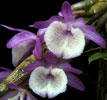|
|
|
|
|
| |
Flasks of
Dendrobium primulinum 'Phoenix' × self |
|
| |
|
|
| |
| Number: |
TN3034 |
| Name: |
Dendrobium primulinum 'Phoenix' × self
|
| Type: |
self (What's that?) |
|
Seed Donor: |
Dale Borders
|
|
Click to Enlarge

Pod Parent Flowers |
Click to Enlarge

Pod Parent Cane with Flowers |
|
|
|
| |
Culture Notes from Donor: Parent plant: Temperature range I (60-83°F)
Comments: Parent plant: A floriferous deciduous dendrobium. Less demanding of a cool winter rest than most deciduous dendrobiums. Flowers highly scented of primrose.
For additional origin/habitat information supplied courtesy of
Charles and Margaret Baker, see further below, near the bottom of this page.
|
Temperatures we attempt to use in the lab & greenhouse:
| For Species: |
|
Summer, Autumn: days average 81°F, nights 67°F; best fit is Intermediate 83-60°F
(Source:
Baker's Web OSC) |
| For Species: |
|
Spring: days average 87°F, nights 60°F; best fit is Intermediate 83-60°F
(Source:
Baker's Web OSC) |
| For Species: |
|
Winter: days average 79°F, nights 49°F; best fit is Cool 70-52°F
(Source:
Baker's Web OSC) |
|
About the name...
| Etymology of |
Dendrobium |
|
From Greek "dendron" tree and "bios" life.
(Source:
Pridgeon 1992) |
| Etymology of |
primulinum |
|
From Latin "primulinus" yellow like a primrose.
(Source:
Mayr & Schmucker 1998) |
| Pronunciation of |
Dendrobium |
|
den-DRO-bee-um
(Source:
Pridgeon 1992) |
| Pronunciation of |
primulinum |
|
prim-yoo-LEE-num
(Source:
Hawkes 1978) |
|
If you would like to direct someone to this web page, please copy and paste this URL into your email:
http://troymeyers.com/d?013034
| Flask Information |
| Availability: |
We have sold all of the flasks for this item. |
| You should: |
Consider getting individual plants or compots instead of a flask.
You can place a "Notify Flask Recipients" Request, and either we or a flask recipient may contact you when plants are available.
You may also place a "Notify Retries" Request, and if an identical pollination (the same parents) is done again, we'll let you know.
You may reserve a flask, but it's very unlikely you'll get one ...this could only happen if we found a flask that we didn't know we had. |
| Yield Estimate: |
530 plants (based on flask surveys done 04/09/2004 through 12/23/2004)
|
| Plantlet Sizes: |
From many flasks 0.3 - 80 mm plants (based on flask surveys done 02/10/2004 through 06/10/2005)
From one most recently surveyed flask 45 - 80 mm (06/10/2005)
|
|
You might also want to:
|
View the seed assay for this item.
View items of the same species.
View items of the same genus.
|
| Ordering Information |
| You are not currently logged in. |
|
You must be a registered user and be logged in to reserve a flask or place a notification request. Please log in:
|
|
|
|
|
|
| |
The origin/habitat information below is supplied courtesy of Charles and Margaret Baker
The following information is based on the name of the plant provided by the donor, and assumes that the name is correct. If the plant has been misidentified, then the following information may not be correct.
This text is copyrighted by the Bakers and may not be reproduced without permission.
ORIGIN/HABITAT: Widespread in India and Southeast Asia. Distribution
extends from near Mussorie in the Garhwal region of northern India,
through Nepal, Sikkim, and the Lushai Hills region of northeastern India,
the Chin Hills of Burma, the mountains of northern and western Thailand,
the Vientiane region of Laos, the Dalat, Blao, and Langbian regions in
Vietnam, and Yunnan Province in southwestern China. Plants usually grow on
deciduous trees at 1640-5250 ft. (500-1600 m).
More about this information and the Bakers...
|
|
|
| |
|
|
|